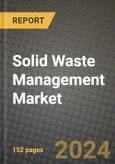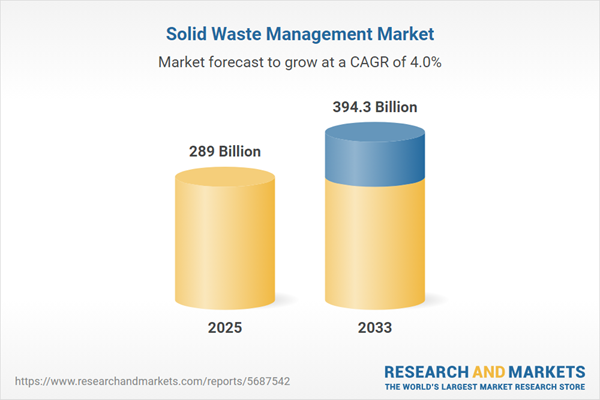The solid waste management market is a critical sector in the global push toward environmental sustainability, driven by rapid urbanization, industrialization, and rising consumerism. Solid waste management encompasses the collection, transportation, processing, recycling, and disposal of municipal, industrial, and hazardous wastes. With waste volumes increasing in both developed and developing regions, governments and private operators are under pressure to adopt more efficient and sustainable waste management practices. Public awareness of the environmental and health consequences of improper waste disposal has led to stricter regulations and a surge in investments toward infrastructure development, waste-to-energy projects, and recycling technologies. The market is evolving with a strong emphasis on circular economy principles, aiming not just to manage waste but to recover resources and minimize landfill dependence. Growing support from environmental policies, coupled with advancements in waste sorting, composting, and anaerobic digestion technologies, is pushing the industry toward a more integrated and intelligent model of waste management.
In 2024, the solid waste management market witnessed several transformative shifts as stakeholders responded to rising waste volumes and stricter climate commitments. Cities around the world ramped up smart waste collection programs using IoT sensors and AI-powered routing systems to reduce operational costs and carbon emissions. Waste-to-energy (WTE) projects gained momentum, particularly in regions where land availability is limited and energy demand is growing. Notably, countries in Southeast Asia and the Middle East advanced public-private partnerships to finance large-scale integrated waste management facilities. Meanwhile, stricter regulations on single-use plastics and e-waste disposal triggered growth in recycling infrastructure and material recovery facilities (MRFs). The use of robotics and automation in sorting plants improved the efficiency of recyclable material recovery and reduced human exposure to hazardous waste. Additionally, startups and innovators focused on turning organic waste into biofuels and compost, aligning with global efforts to reduce methane emissions from landfills. These developments set a solid foundation for a more technologically advanced and environmentally responsible waste management sector.
Looking ahead to 2025 and beyond, the solid waste management market is expected to pivot further toward digitization, decentralization, and decarbonization. Municipalities are likely to expand smart bin networks and AI-based waste forecasting tools to enhance efficiency and transparency in collection and processing. Circular economy strategies will be more deeply embedded in public policy, pushing industries to adopt extended producer responsibility (EPR) models and design products with end-of-life recyclability in mind. Emerging technologies such as chemical recycling, carbon capture from incinerators, and blockchain-enabled waste tracking will gain traction to address complex waste streams and improve accountability. Developing nations are projected to see increased investments in formalizing informal waste sectors, providing both environmental and socioeconomic benefits. At the same time, climate-linked funding and ESG mandates will encourage private capital to flow into green waste infrastructure. However, the sector will continue to face challenges related to financing, policy enforcement, and consumer participation, all of which are essential for achieving a truly sustainable waste management ecosystem.
Key Insights: Solid Waste Management Market
- Smart waste management solutions using IoT, GPS, and AI are enabling real-time tracking, dynamic route optimization, and predictive collection schedules, improving operational efficiency and reducing emissions from waste transportation fleets.
- Waste-to-energy projects are expanding, particularly in densely populated or land-constrained regions, offering a dual benefit of reducing landfill dependency and generating renewable energy from non-recyclable waste streams.
- Rise of decentralized composting and anaerobic digestion units is promoting local waste processing, especially in urban areas where food and organic waste make up a large share of municipal waste.
- Automation and robotics in material recovery facilities are improving the quality and speed of recyclable material sorting, reducing labor costs and contamination rates in plastic, metal, and paper recycling lines.
- Plastic and e-waste bans are reshaping global recycling flows, prompting countries to invest in domestic processing capabilities and tighten regulations on waste imports and informal dumping practices.
- Increasing urbanization and population growth are generating larger volumes of waste, prompting cities to adopt scalable and efficient waste management systems to maintain hygiene and environmental standards.
- Stricter environmental regulations and climate targets are pushing both public and private sectors to reduce landfill usage and invest in sustainable waste treatment solutions like recycling and energy recovery.
- Growing public awareness of plastic pollution, food waste, and the environmental impact of landfills is influencing consumer behavior and supporting waste reduction, segregation, and recycling initiatives.
- Government incentives, public-private partnerships, and ESG-focused investments are fueling the development of advanced infrastructure and technology-driven solutions for efficient and circular waste management practices.
- Inconsistent regulatory enforcement and lack of standardized waste segregation practices remain a key challenge. Without uniform policies and public compliance, even advanced systems struggle to operate efficiently, leading to contamination in recycling streams and underutilized waste treatment capacities.
Solid Waste Management Market Segmentation
By Waste:
- Municipal
- Industrial
By Material:
- Paper And Paperboard
- Plastic
- Metals
- Food
- Textiles
- Other Materials
By Service:
- Open dumping
- Incineration Or Combustion
- Landfill
- Recycling
- Composting And Anaerobic Digestion
By End-User:
- Residential
- Commercial
- Industrial
By Geography:
- North America (USA, Canada, Mexico)
- Europe (Germany, UK, France, Spain, Italy, Rest of Europe)
- Asia-Pacific (China, India, Japan, Australia, Vietnam, Rest of APAC)
- The Middle East and Africa (Middle East, Africa)
- South and Central America (Brazil, Argentina, Rest of SCA)
Solid Waste Management Market Size Data, Trends, Growth Opportunities, and Restraining Factors:
- This comprehensive Solid Waste Management market report delivers updated market size estimates from 2024 to 2034, offering in-depth analysis of the latest Solid Waste Management market trends, short-term and long-term growth drivers, competitive landscape, and new business opportunities. The report presents growth forecasts across key Solid Waste Management types, applications, and major segments, alongside detailed insights into the current Solid Waste Management market scenario to support companies in formulating effective market strategies.
- The Solid Waste Management market outlook thoroughly examines the impact of ongoing supply chain disruptions and geopolitical issues worldwide. Factors such as trade tariffs, regulatory restrictions, production losses, and the emergence of alternatives or substitutes are carefully considered in the Solid Waste Management market size projections. Additionally, the analysis highlights the effects of inflation and correlates past economic downturns with current Solid Waste Management market trends, providing actionable intelligence for stakeholders to navigate the evolving Solid Waste Management business environment with precision.
Solid Waste Management Market Competition, Intelligence, Key Players, and Winning Strategies to 2034:
- The 2025 Solid Waste Management Market Research Report identifies winning strategies for companies to register increased sales and improve market share.
- Opinions from senior executives from leading companies in the Solid Waste Management market are imbibed thoroughly and the Solid Waste Management industry expert predictions on the economic downturn, technological advancements in the Solid Waste Management market, and customized strategies specific to a product and geography are mentioned.
- The Solid Waste Management market report is a source of comprehensive data and analysis of the industry, helping businesses to make informed decisions and stay ahead of the competition. The Solid Waste Management market study assists investors in analyzing On Solid Waste Management business prospects by region, key countries, and top companies' information to channel their investments.
- The report provides insights into consumer behavior and preferences, including their buying patterns, brand loyalty, and factors influencing their purchasing decisions. It also includes an analysis of the regulatory environment and its impact on the Solid Waste Management industry. Shifting consumer demand despite declining GDP and burgeoning interest rates to control surging inflation is well detailed.
What's Included in the Report?
- Global Solid Waste Management market size and growth projections, 2024-2034
- North America Solid Waste Management market size and growth forecasts, 2024-2034 (United States, Canada, Mexico)
- Europe market size and growth forecasts, 2024-2034 (Germany, France, United Kingdom, Italy, Spain)
- Asia-Pacific Solid Waste Management market size and growth forecasts, 2024-2034 (China, India, Japan, South Korea, Australia)
- Middle East Africa Solid Waste Management market size and growth estimate, 2024-2034 (Middle East, Africa)
- South and Central America Solid Waste Management market size and growth outlook, 2024-2034 (Brazil, Argentina, Chile)
- Solid Waste Management market size, share and CAGR of key products, applications, and other verticals, 2024-2034
- Short- and long-term Solid Waste Management market trends, drivers, challenges, and opportunities
- Solid Waste Management market insights, Porter’s Five Forces analysis
- Profiles of 5 leading companies in the industry - overview, key strategies, financials, product portfolio and SWOT analysis
- Latest market news and developments
Key Questions Answered in This Report:
- What is the current Solid Waste Management market size at global, regional, and country levels?
- What is the market penetration of different types, Applications, processes/technologies, and distribution/sales channels of the Solid Waste Management market?
- What will be the impact of economic slowdown/recission on Solid Waste Management demand/sales?
- How has the global Solid Waste Management market evolved in past years and what will be the future trajectory?
- What is the impact of growing inflation, Russia-Ukraine war on the Solid Waste Management market forecast?
- What are the Supply chain challenges for Solid Waste Management?
- What are the potential regional Solid Waste Management markets to invest in?
- What is the product evolution and high-performing products to focus in the Solid Waste Management market?
- What are the key driving factors and opportunities in the industry?
- Who are the key players in Solid Waste Management market and what is the degree of competition/Solid Waste Management market share?
- What is the market structure /Solid Waste Management Market competitive Intelligence?
Available Customizations:
The standard syndicate report is designed to serve the common interests of Solid Waste Management Market players across the value chain, and include selective data and analysis from entire research findings as per the scope and price of the publication.However, to precisely match the specific research requirements of individual clients, several customization options are offered to include the data and analysis of interest in the final deliverable.
Some of the customization requests are as mentioned below:
- Segmentation of choice - Clients can seek customization to modify/add a market division for types/applications/end-uses/processes of their choice.
- Solid Waste Management Pricing and Margins Across the Supply Chain, Solid Waste Management Price Analysis / International Trade Data / Import-Export Analysis.
- Supply Chain Analysis, Supply-Demand Gap Analysis, PESTLE Analysis, Macro-Economic Analysis, and other Solid Waste Management market analytics.
- Processing and manufacturing requirements, Patent Analysis, Technology Trends, and Product Innovations.
- Further, the client can seek customization to break down geographies as per their requirements for specific countries/country groups such as South East Asia, Central Asia, Emerging and Developing Asia, Western Europe, Eastern Europe, Benelux, Emerging and Developing Europe, Nordic countries, North Africa, Sub-Saharan Africa, Caribbean, The Middle East and North Africa (MENA), Gulf Cooperation Council (GCC) or any other.
- Capital Requirements, Income Projections, Profit Forecasts, and other parameters to prepare a detailed project report to present to Banks/Investment Agencies.
Additional support:
- All the data presented in tables and charts of the report is provided in a separate Excel document
- Print authentication allowed on purchase of online versions
- 10% free customization to include any specific data/analysis to match the requirement
- 7 days of analyst support
This product will be delivered within 1-3 business days.
Table of Contents
Table Information
| Report Attribute | Details |
|---|---|
| No. of Pages | 150 |
| Published | August 2025 |
| Forecast Period | 2025 - 2033 |
| Estimated Market Value ( USD | $ 289 Billion |
| Forecasted Market Value ( USD | $ 394.3 Billion |
| Compound Annual Growth Rate | 4.0% |
| Regions Covered | Global |









